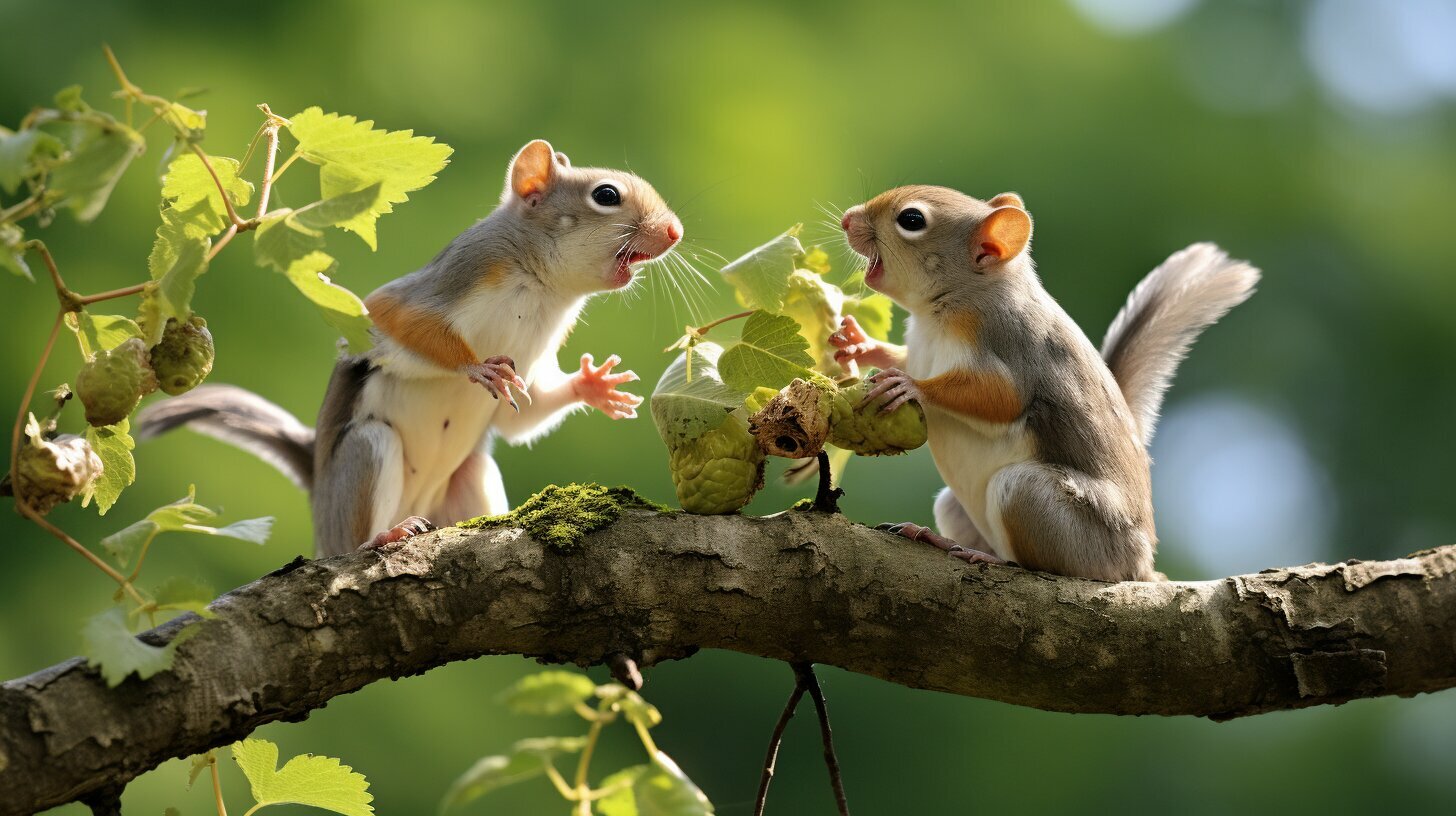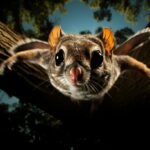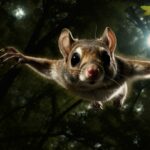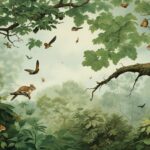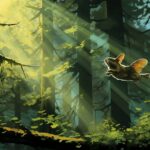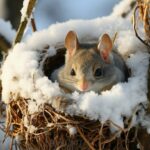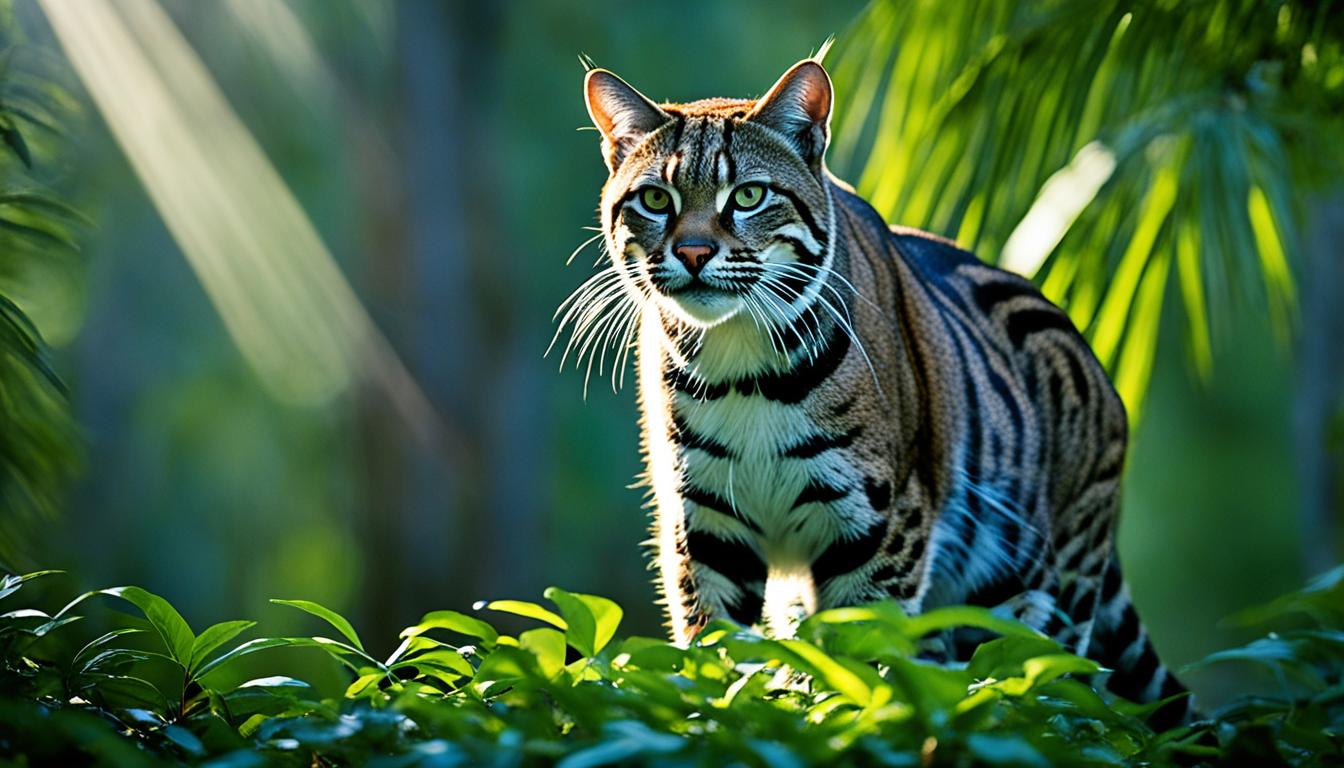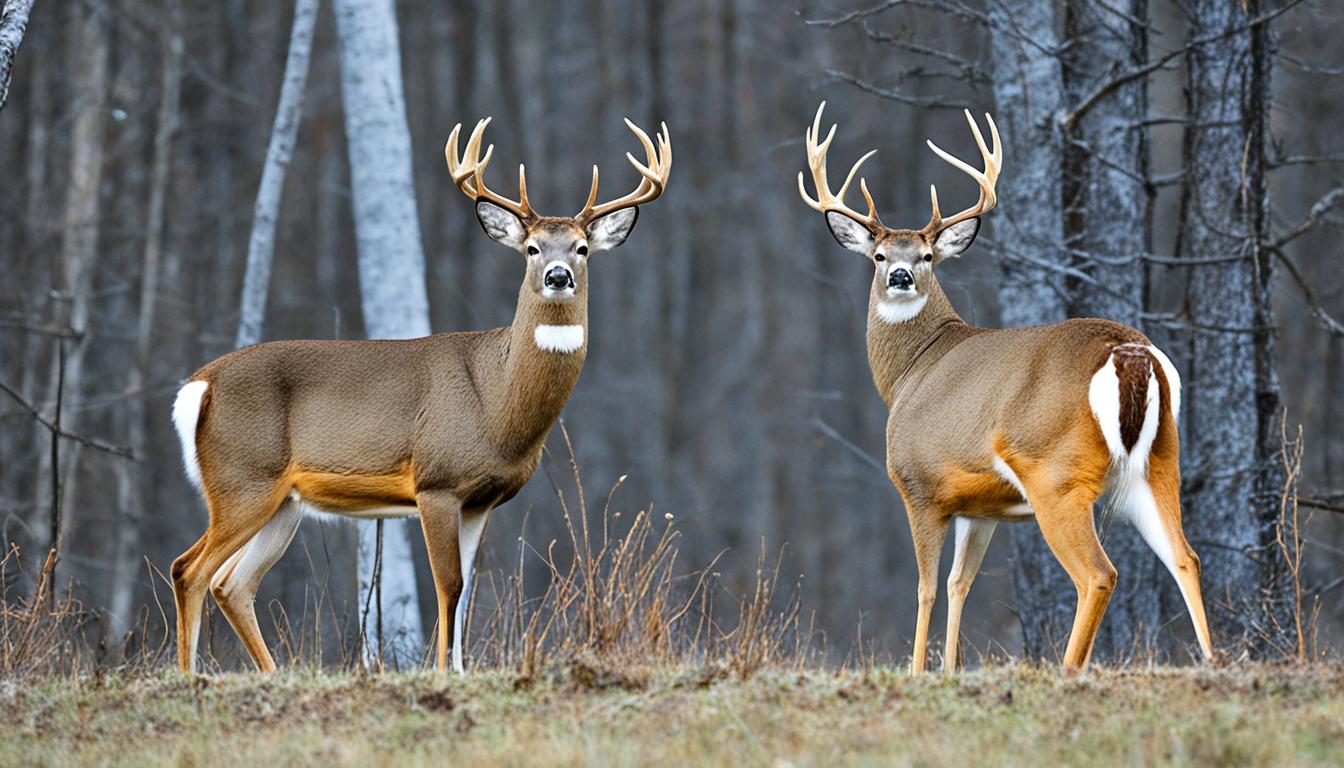Flying squirrel reproduction is a captivating process that showcases the intricate breeding habits of these remarkable creatures. Southern flying squirrels, specifically Glaucomys volans, possess unique characteristics that make their reproduction cycle truly fascinating. With their gliding membrane, gray fur, and white bellies, these nocturnal creatures are perfectly adapted to their woodland habitat.
During the warmer months, southern flying squirrels engage in mating behaviors that are not well-known to researchers. They typically mate twice a year and the females remain pregnant for approximately 40 days. The female squirrels give birth to a litter of 1 to 6 young, who are born naked and helpless. These young squirrels grow and mature rapidly, reaching adulthood in just one year.
Living in hollow trees or deserted woodpecker holes, flying squirrels are known for their impressive gliding abilities. They use their stretched skin as a sail and can cover long distances through the air. Their diet consists of a variety of foods, including nuts, acorns, seeds, berries, insects, and sometimes even small birds and their eggs. Their nocturnal and agile nature helps them avoid predators and survive in their woodland environment.
One intriguing feature of southern flying squirrels is their ability to glow pink under a blacklight. While the reason behind this phenomenon remains unknown, it is believed to serve a purpose in avoiding predators or attracting potential mates.
Key Takeaways:
- Flying squirrel reproduction involves captivating mating behaviors and a unique reproductive cycle.
- Southern flying squirrels mate twice a year and have a gestation period of approximately 40 days.
- Female squirrels give birth to 1 to 6 young, who grow and mature rapidly.
- Flying squirrels possess impressive gliding abilities and are mainly active at night.
- They have a diverse diet, including nuts, acorns, seeds, berries, insects, and sometimes small birds and eggs.
- Their nocturnal and agile nature helps them avoid predators.
- The ability of flying squirrels to glow pink under a blacklight remains a mystery, but it may have evolutionary advantages.
Mating Behaviors and Strategies of Flying Squirrels
Flying squirrels exhibit a variety of intriguing mating behaviors and reproductive strategies that contribute to the successful continuation of their species. These agile creatures employ a range of tactics to ensure successful reproduction, from intricate courtship rituals to strategic mate selection.
One notable behavior is the males’ impressive acrobatic displays during courtship. They showcase their agility by performing daring aerial maneuvers, gliding through the forest canopy with grace and precision. This display not only helps attract potential mates but also serves as a demonstration of their fitness and genetic quality.
Another interesting reproductive strategy of flying squirrels is delayed implantation. This unique adaptation allows females to delay the development of fertilized eggs within their womb, ensuring that the young are born during favorable conditions. By carefully selecting the timing of implantation, females can increase the chances of survival for their offspring.
“Flying squirrels are known to form monogamous pair bonds, with males and females engaging in cooperative breeding.”
Cooperative breeding and communal nesting
Flying squirrels are known to form monogamous pair bonds, with males and females engaging in cooperative breeding. This means that both parents actively participate in rearing their young, from nest construction to the provisioning of food. It is believed that this cooperative behavior helps increase the survival rate of offspring and strengthens the bond between mates.
Furthermore, flying squirrels often engage in communal nesting, where several individuals share a single nest. This behavior provides advantages in terms of thermoregulation, as the collective body heat generated by multiple squirrels helps keep the nest warm during colder months. Additionally, communal nesting also serves as a form of protection against predators, as the increased numbers create a greater sense of safety for all members of the group.
Table: Mating Behaviors and Reproductive Strategies of Flying Squirrels
| Mating Behaviors | Reproductive Strategies |
|---|---|
| Aerial courtship displays | Delayed implantation |
| Monogamous pair bonding | Cooperative breeding |
| Communal nesting |
In conclusion, the mating behaviors and reproductive strategies of flying squirrels are a testament to their remarkable adaptation and evolutionary success. From acrobatic courtship displays to delayed implantation and cooperative breeding, these small creatures have evolved a range of strategies to ensure the continuation of their species. By understanding and appreciating these behaviors, we can gain valuable insights into the complexity of nature and the importance of preserving the habitats that support these fascinating creatures.
The Reproductive Cycle of Southern Flying Squirrels
The reproductive cycle of southern flying squirrels follows a distinct pattern, with defined stages that lead to the birth of their adorable offspring. These fascinating creatures exhibit an interesting process that ensures the continuation of their species. Let’s take a closer look at their reproductive cycle, including the gestation period and the various stages involved.
The first stage of the reproductive cycle is mating, which typically occurs during the warmer months. Male flying squirrels engage in courtship rituals to attract a suitable mate. Once a pair has formed, they embark on a mating journey that can last several hours. The male deposits sperm into the female’s reproductive tract, and fertilization takes place internally.
After successful mating, the female enters the gestation period, which lasts approximately 40 days. During this time, she prepares a nest in a hollow tree or deserted woodpecker hole, providing a safe and sheltered environment for her forthcoming offspring. The female gives birth to a litter of 1 to 6 young, known as kits or pups.
Upon birth, the kits are helpless and naked, relying entirely on their mother for nourishment and care. The mother squirrel nurses her young with milk, ensuring their healthy growth and development. As they grow, the kits begin to explore their surroundings within the safety of the nest. By the time they reach one year old, they are fully grown and ready to embark on their own reproductive journeys.
| Stage | Duration |
|---|---|
| Mating | Varies |
| Gestation Period | Approximately 40 days |
| Birth of Kits | 1 to 6 young |
The reproductive cycle of southern flying squirrels is a fascinating process that contributes to the survival and diversity of these remarkable creatures. Understanding their reproductive habits and the various stages involved is crucial for wildlife conservation efforts and protecting their natural habitats.
Mating Season and Breeding Success of Flying Squirrels
Flying squirrels have a specific mating season when they engage in courtship rituals and mate, ultimately determining the success of their breeding endeavors. This mating season typically occurs during the warmer months of the year, when food availability is abundant, and the weather conditions are favorable. During this time, male flying squirrels actively seek out female mates, engaging in various displays and vocalizations to attract a partner.
Once a male has successfully courted a female, they will mate, usually within the safety of their tree hollow or woodpecker hole nest. Female flying squirrels have a gestation period of approximately 40 days, after which they give birth to a litter of 1 to 6 young. These newborn squirrels are born naked and helpless, relying entirely on their mother for nourishment and protection.
Flying squirrels have evolved unique adaptations that contribute to their breeding success. Their ability to glide through the air using their gliding membrane allows them to access isolated areas for mating and find suitable nesting sites high in the trees. Additionally, their nocturnal behavior helps reduce the risk of predation, as they are less likely to encounter diurnal predators during their active hours. These factors, coupled with their reproductive strategies, ensure the survival and continuation of their species.
The Importance of Habitat and Food Availability
One crucial factor influencing the mating season and breeding success of flying squirrels is the availability of suitable habitat and food sources. Flying squirrels prefer woodlands, particularly areas with seed-producing hardwood trees. These trees provide not only a reliable food source but also ideal nesting sites within the tree cavities. Therefore, the presence of a diverse range of healthy trees is essential for the successful reproduction of these remarkable creatures.
Furthermore, the abundance of food during the mating season plays a critical role. Flying squirrels are omnivores, consuming a varied diet that includes nuts, acorns, seeds, berries, insects, and even small birds and their eggs. A sufficient food supply ensures that both the male and female squirrels have the necessary energy and nutrients to engage in courtship and reproductive activities. In turn, this contributes to the breeding success of flying squirrels, as well as the overall population health.
| Factors Influencing Breeding Success | Description |
|---|---|
| Availability of suitable nesting sites | Flying squirrels require hollow trees or deserted woodpecker holes for their nests, providing a safe and secure environment for breeding. |
| Abundance of food resources | A diverse range of food sources ensures that flying squirrels have the necessary energy and nutrients for successful mating and reproduction. |
| Presence of healthy habitat | Woodlands with seed-producing hardwood trees provide the ideal habitat for flying squirrels, offering both food and nesting opportunities. |
In conclusion, the mating season and breeding success of flying squirrels are influenced by various factors, including the availability of suitable nesting sites, the abundance of food resources, and the overall health of their habitat. Understanding and preserving these factors are crucial for the conservation of these fascinating creatures and their unique reproductive behaviors.
Factors Influencing Flying Squirrel Reproduction
Flying squirrel reproduction can be influenced by a range of factors that shape their breeding patterns and impact their overall reproductive success. These factors include habitat availability, food availability, and environmental conditions.
When it comes to habitat availability, flying squirrels rely on mature forests with a sufficient number of suitable nesting sites. They prefer areas with seed-producing hardwood trees, which provide them with a reliable food source. Loss of habitat due to deforestation or urbanization can significantly impact their reproductive success and population size.
Food availability is another crucial factor. Flying squirrels are omnivores and have a diverse diet, including nuts, acorns, seeds, berries, insects, and even small birds and their eggs. The availability of these food sources can vary seasonally, and fluctuations can affect the squirrels’ reproductive cycles and overall health.
Environmental conditions also play a role in flying squirrel reproduction. Temperature, precipitation, and other climatic factors can impact their breeding behaviors and the survival of their young. Extreme weather events, such as droughts or severe storms, can disrupt their mating patterns and reduce their breeding success.
| Factors Influencing Flying Squirrel Reproduction | Description |
|---|---|
| Habitat availability | Availability of mature forests with suitable nesting sites. |
| Food availability | Access to a diverse range of food sources throughout the year. |
| Environmental conditions | Climatic factors like temperature, precipitation, and extreme weather events. |
Understanding these factors and their impact on flying squirrel reproduction is essential for conservation efforts. By preserving and maintaining their natural habitats, ensuring a steady food supply, and considering the potential effects of climate change, we can help protect these unique and fascinating creatures for future generations to enjoy.
The Life Cycle of Flying Squirrels
The life cycle of flying squirrels encompasses the remarkable journey from birth to adulthood, as these tiny creatures grow and develop into skilled gliders. Let’s take a closer look at the different stages they go through during their reproductive cycle.
Birth: Southern flying squirrels give birth to 1 to 6 young, known as kits, after a gestation period of about 40 days. The kits are born naked and helpless, relying completely on their mother for nourishment and protection.
Infancy: During the first few weeks of life, the kits rely on their mother’s milk for sustenance and grow rapidly. Their eyes and ears open, and they begin to explore their surroundings within the safety of their nest. The mother diligently cares for her young, ensuring their warmth and safety.
Independence: As the kits grow older, they become more independent and start venturing outside the nest. They develop their gliding abilities, practicing short glides from tree to tree under the watchful eyes of their mother. This period is crucial for them to hone their skills and gain confidence in navigating their forest habitat.
Adulthood: By the time the kits reach around one year of age, they are considered adults and fully matured. They have mastered the art of gliding and are capable of covering long distances with ease. They are now ready to find their own territories and establish their place within the forest ecosystem.
| Life Cycle of Flying Squirrels | |
|---|---|
| Birth | Kits are born naked and helpless |
| Infancy | Kits rely on mother’s milk and explore the nest |
| Independence | Kits develop gliding abilities and venture outside nest |
| Adulthood | Fully matured squirrels capable of long distance gliding |
The life cycle of flying squirrels is a testament to their incredible adaptation to woodland habitats and their ability to thrive in challenging environments. By understanding the various stages of their reproduction process, we can develop a deeper appreciation for these fascinating creatures and work towards their conservation and preservation.
Conclusion
The captivating process of flying squirrel reproduction plays a crucial role in sustaining these unique creatures, highlighting the importance of conserving their natural habitats and protecting their breeding habitats. Southern flying squirrels, known for their distinctive gliding membrane and gray fur, are found in woodlands, particularly in areas with seed-producing hardwood trees. Although the specific details of their mating process are not well-known, they typically mate twice a year during the warmer months. Female squirrels carry their young for approximately 40 days before giving birth to 1 to 6 offspring.
These young squirrels are born naked and helpless, relying on their mother’s care until they are fully grown at around one year old. Southern flying squirrels are primarily nocturnal and seek refuge in hollow trees or deserted woodpecker holes. They use their stretched skin as a sail, gliding effortlessly through the air to cover long distances.
Omnivorous by nature, flying squirrels have a varied diet that includes nuts, acorns, seeds, berries, insects, and even small birds and their eggs. They have evolved to be agile and elusive tree-dwellers, avoiding potential predators by their nocturnal habits and quick movements among the branches. An interesting characteristic of these creatures is their ability to glow pink under a blacklight, although the exact purpose of this phenomenon remains a mystery.
Understanding the intricacies of flying squirrel reproduction is essential for wildlife conservation efforts. By preserving their natural habitats and protecting their breeding grounds, we can ensure the long-term survival of these remarkable creatures. Through continued research and conservation initiatives, we can contribute to the preservation of these captivating animals and their unique reproductive process.
How Does Poaching Affect the Reproduction of Flying Squirrels?
Flying squirrels are negatively impacted by poaching, as it disrupts their natural habitat and food sources. Gorilla poaching statistics revealed the devastating effects poaching has on wildlife populations. This illegal activity threatens the reproduction and survival of many species, including flying squirrels, and contributes to their decline in numbers.
FAQ
Q: How do flying squirrels mate?
A: The mating process of flying squirrels is not well-known, but they usually mate twice a year during the warmer months.
Q: How long is the gestation period for southern flying squirrels?
A: Female squirrels are pregnant for about 40 days before giving birth to 1 to 6 young.
Q: Where do flying squirrels live?
A: Flying squirrels live in hollow trees or deserted woodpecker holes in woodlands, preferably near seed-producing hardwood trees.
Q: What do flying squirrels eat?
A: Flying squirrels are omnivores and eat a variety of foods, including nuts, acorns, seeds, berries, insects, and even small birds and their eggs.
Q: Why do flying squirrels glow pink under a blacklight?
A: It is still unknown why flying squirrels have the ability to glow pink under a blacklight, but it is thought that it might help them avoid predators or attract mates.

